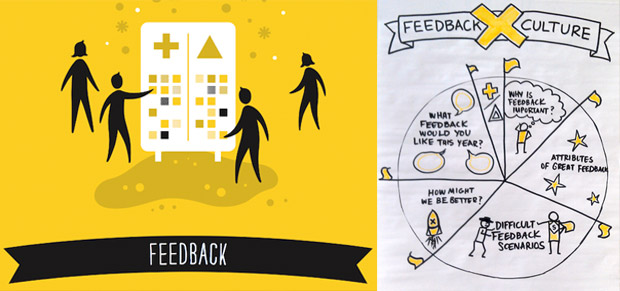This guest post comes from Nick Fassler, founder and CEO of Thrively, an online tool that makes it simple to exchange constructive feedback with the people you work with. He was invited to the Portland XPLANE office from San Francisco to help with a Visual Thinking School (VTS) session focused on improving XPLANE’s feedback culture. We were excited to have him join us and share his experience.
“A feedback culture is our fastest path to excellence.”
— Aric Wood, CEO of XPLANE
The team at XPLANE gathered on a Friday afternoon to answer this question: “How do we foster a culture of feedback?” As part of XPLANE’s vision and strategy for 2015 (published as a visually stunning XPLANATiON, of course), the company made feedback a major component of their culture map. CEO Aric Wood kicked off the session to explain why: “Creating a feedback culture is our fastest path to excellence. It’s what makes us smarter, faster, and improve at an organizational and individual level.” He acknowledged that while XPLANE had already created a strong culture of trust and openness, and has baked feedback into meetings and client projects, there is still significant room to grow and improve.
In their signature visual thinking style, the team spent the better part of the next two hours brainstorming with whiteboards and post-it notes on what it would mean to build a better feedback culture. Led by teammates Stephanie Gioia and Kathryn Jarrell, the team came up with a myriad of use cases for feedback, covering their strengths (project post-mortems, meeting plus/deltas, one-on-ones, and employee surveys) and their opportunities for improvement (design critiques, teammate on-the-spot feedback, strategic management feedback, and ongoing client feedback). And of course, we can’t forget performance reviews, which made their way onto both lists.
Next, the question was posed: “What are the common attributes of great feedback?” Some of the most common post-its that made it to the wall: respectful, specific, timely, direct, constructive, and actionable. The full list covered upward of 100 post-its, but here are some of my other favorites: with permission, non-defensive, curious, non-judgmental, with empathy, with love, supports failure, private, in your best interest, and as a gift. There was some disagreement though: should feedback be brutally honest or delivered with a light touch? This was a clear case where knowing your audience really mattered. It is also why asking permission, and making sure you are respectful and constructive, is so important.
With this list of feedback attributes in mind, we jumped right into skit time! We divided into four groups to tackle challenging feedback topics. Our mandate: act out each feedback topic with a “feedback villain” and a “feedback hero”. My group was chosen to act out giving feedback when you know it will shatter the confidence of the person you are giving it to. As the only outsider, I was selected to be the target of this brutal feedback. My character: a newbie sales person who just bombed his first client sales meeting, and was looking for encouraging feedback so he wouldn’t feel so bad. Act One, “feedback villain”, included a mixture of direct onslaught (“That was horrible, we probably lost the client because of you”) and talking behind my back (“Can you believe that guy?”). Act Two, “feedback hero”, was much easier to take. The team gave me honest but supportive feedback on what I did right and how to improve (“You did a great job designing the presentation, but we don’t think the client was very engaged. We’d love for you to spend some time with Tim, he’s been our lead sales person and can probably offer lots of helpful tools.”). This exercise was great, but also showcased an essential truth: it takes practice and patience to get good at delivering (and receiving) feedback.
After witnessing four hilarious but admittedly awkward feedback skits, the team members turned inward to share what they personally wanted more feedback on. Requesting feedback is definitely a great strategy for making feedback less awkward, but it requires self-awareness and trust (luckily, the XPLANE team has lots of both). As individuals, the team wanted feedback on some of the same issues we all struggle with at work: listening, delegating and saying ‘no’, staying focused, taking things less personally, speaking up, following up, control issues, interrupting less, complaining less, and being present. After the session, all of the personal goals were shared on a public document so the team members could provide welcomed feedback on the challenges they face.
As with any good feedback session, we ended with a plus/delta about the meeting itself. What worked: I left the session with a really good picture of the inner workings of a true feedback culture. A feedback culture isn’t some perfect ideal, but a culture that acknowledges both strengths and challenges, and understands that this is why we need feedback in the first place. While XPLANE isn’t perfect, just the fact that they would engage in such an honest conversation about feedback (not to mention, let an outsider come in to write about it) puts them leagues ahead of most companies in my book. And what I’d change: getting better at feedback is a long-term effort, and I wanted to see more solid commitments of how the team was going to make improvements. I trust that they will, and look forward to hearing about their progress.

